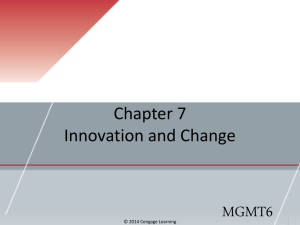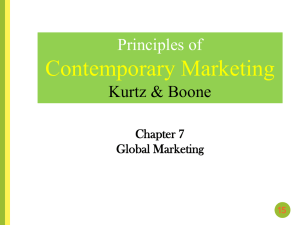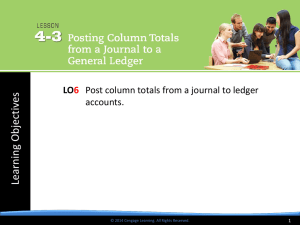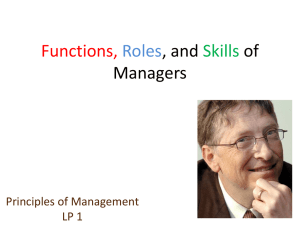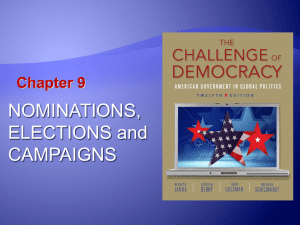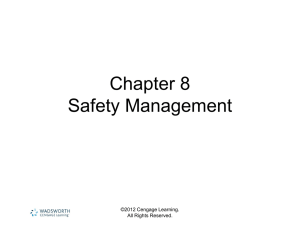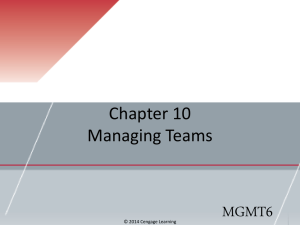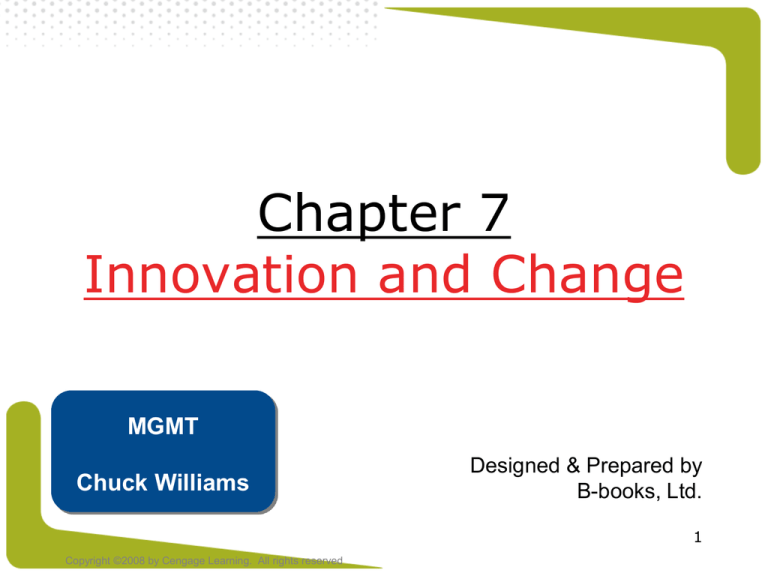
Chapter 7
Innovation and Change
MGMT
Chuck Williams
Designed & Prepared by
B-books, Ltd.
1
Copyright ©2008 by Cengage Learning. All rights reserved
Organizational Innovation
After reading these sections,
you should be able to:
1. explain why innovation matters to companies.
2. discuss the different methods that managers
can use to effectively manage innovation in
their organizations.
2
Copyright ©2008 by Cengage Learning. All rights reserved
Why Innovation Matters
Technology
Cycles
Innovation
Streams
1
3
Copyright ©2008 by Cengage Learning. All rights reserved
Why Innovation Matters
1900-1910
• airplane, plastic, air
conditioner
1911-1920
• mammogram, zipper, sonar
1921-1930
• talking movies, penicillin, jet
engine
1931-1940
• radar, helicopter, computer
1941-1950
• atomic bomb, bikini, transistor
1951-1960
• oral contraceptive, Tylenol
1961-1970
• video recorder, handheld
calculator, computer mouse
1971-1980
• compact disc, gene splicing,
laser printer
1981-1990
• MS-DOS, space shuttle,
CD-ROM
1991-2000
• taxol, Pentium processor, Java
2001-Today
• first cloning of human embryo
1
4
Copyright ©2008 by Cengage Learning. All rights reserved
Technology Cycles
Technology Cycle
A cycle that begins with the birth” of a
new technology and ends when that
technology reaches its limits and is
replaced by a newer, better technology.
1.1
5
Copyright ©2008 by Cengage Learning. All rights reserved
S-Curves and Technological
Innovation
Performance
Discontinuity
C
New
Technology
B
A
Effort
1.1
6
Copyright ©2008 by Cengage Learning. All rights reserved
Innovation Streams
Innovation Streams
Patterns of innovation over time that can
create sustainable competitive advantage.
Technological Discontinuity
A scientific advance or unique combination of
existing technologies that creates a significant
breakthrough in performance or function.
1.2
7
Copyright ©2008 by Cengage Learning. All rights reserved
Innovation Streams:
Technology Cycles over Time
Technological
Discontinuity (2)
Technological
Substitution
Era of
Incremental
Change (2)
Variation
Selection
Discontinuous
Change(2)
Dominant
Design (2)
Technological
Discontinuity (1)
Era of
Incremental
Change (1)
1.2
Variation
Selection
Discontinuous
Change(1)
Dominant
Design (1)
8
Copyright ©2008 by Cengage Learning. All rights reserved
Innovation Streams
Technological
Discontinuities
Technological
Substitution
Discontinuous
Change
Design
Competition
Dominant Design
1.2
9
Copyright ©2008 by Cengage Learning. All rights reserved
Managing Innovation
Managing
Sources of
innovation
Managing During
Discontinuous
Change
Managing During
Incremental
Change
2
10
Copyright ©2008 by Cengage Learning. All rights reserved
Managing Sources of Innovation
Creative work environments
Workplace cultures in which workers
perceive that new ideas are encouraged
Flow
The psychological state of effortlessness in
which you become absorbed in your work and
time seems to pass quickly
2.1
11
Copyright ©2008 by Cengage Learning. All rights reserved
Components of Creative Work Environments
Organizational
Encouragement
Challenging
Work
Lack of Organiz.
Impediments
Creative
Work
Environments
Freedom
Supervisory
Encouragement
Work Group
Encouragement
Flow
2.1
12
Copyright ©2008 by Cengage Learning. All rights reserved
Managing Innovation
During Discontinuous Change
Experiential approach to
innovation
• innovation is occurring within
an uncertain environment
• the key to innovation is to use:
– intuition
– flexible options
– hands-on experience
2.2
13
Copyright ©2008 by Cengage Learning. All rights reserved
Experiential Approach to Innovation
Design Iterations
Testing
Parts of
Experiential
Approach
Milestones
Multifunctional Teams
Powerful Leaders
2.2
14
Copyright ©2008 by Cengage Learning. All rights reserved
Managing Innovation During
Incremental Change
• Compression approach to innovation
– assumes that innovation is a predictable process
that can be planned in steps
• Generational change
– based on incremental improvements to a
dominant design and achieving backward
compatibility with older technology
2.3
15
Copyright ©2008 by Cengage Learning. All rights reserved
Compression Approach
to Innovation
Planning
Supplier Involvement
Parts of
Compression
Approach
Shortening Time of
Individual Steps
Overlapping Steps
Multifunctional Teams
2.3
16
Copyright ©2008 by Cengage Learning. All rights reserved
Managing Innovation
Experimental
Approach
Environment
Uncertain discontinuous
change:
technological substitution
and design competition
Certain incremental change
established technology
(i.e., dominant design)
Speed
Performance Improvements
New dominant design
Speed
Lower costs
Incremental improvements
in performance of dominant
design
Build something new,
different, and better
Compress time/steps needed
to bring about small
improvements
Design iterations
Testing
Milestones
Multifunctional teams
Powerful leaders
Planning
Supplier involvement
Shorten time of steps
Overlapping steps
Multifunctional teams 17
Goals
Approach
2
Steps
Compression
Approach
Copyright ©2008 by Cengage Learning. All rights reserved
Organizational Change
After reading these sections,
you should be able to:
3. discuss why not changing can lead to
organizational decline.
4. discuss the different methods that managers
can use to better manage change as it occurs.
18
Copyright ©2008 by Cengage Learning. All rights reserved
Five Stages of Organizational Decline
Blinded
Inaction
Faulty
Action
Crisis
Dissolution
3
19
Copyright ©2008 by Cengage Learning. All rights reserved
Circuit City in
Retrenchment
Beyond the Book
• Circuit City had only one profitable quarter in 20072008. In November 2008, it had $2.3 billion in debts
with only $3.4 billion in assets.
• Former CEO Philip Schoonover moved to reduce
3,400 higher-paid management positions in March
2007. He was ousted by Circuit City’s board in
September 2008.
• Circuit City filed for Chapter 11 in November 2008
and aims to liquidate 155 U.S. stores and lay off
20% of its workforce in an effort to regroup.
Source: K. Hudson, “Circuit City Enters New Turnaround Stage,” The Wall Street Journal, 31 May 2007, B5; M. Bustillo,
“Circuit City Seeks Haven In Bankruptcy Protection,” The Wall Street Journal, 11 November 2008..
Copyright ©2008 by Cengage Learning. All rights reserved
20
Managing Change
Change Forces
Change
Resistance Forces
4
21
Copyright ©2008 by Cengage Learning. All rights reserved
Managing Change
Managing
resistance
to change
What not
to do when
leading change
Different change
tools and
techniques
4
22
Copyright ©2008 by Cengage Learning. All rights reserved
Managing Resistance to Change
Unfreezing
• Share reasons
• Empathize
• Communicate
Change
Intervention
•
•
•
•
•
•
•
Benefits
Champion
Input
Timing
Security
Training
Pace
Refreezing
• Top management
support
• Reinforce
4.1
23
Copyright ©2008 by Cengage Learning. All rights reserved
Managing Resistance to Change
Education and Communication
Participation
Negotiation
Managerial Support
Coercion
4.1
24
Copyright ©2008 by Cengage Learning. All rights reserved
Errors Made when Leading Change
Unfreezing
1. Not establishing a great enough sense of urgency.
2. Not creating a powerful enough guiding coalition.
Change
3. Lacking a vision.
4. Undercommunicating the vision by a factor of 10.
5. Not removing obstacles to the new vision.
6. Not systematically planning for and creating short-term wins.
Refreezing
7. Declaring victory too soon.
4.2
8. Not anchoring changes in the corporation’s culture.
25
Copyright ©2008 by Cengage Learning. All rights reserved
Change Tools and Techniques
Results-Driven Change
General Electric Workout
Transition Management Teams
Organizational Development
4.3
26
Copyright ©2008 by Cengage Learning. All rights reserved
Results-Driven Change
1. Create measurable short-term goals to improve performance
2. Use action steps only if likely to improve performance
3. Stress the importance of immediate improvements
4. Consultants and staffers should help managers achieve
quick improvements in performance
5. Test action steps to see if they yield improvements
6. It takes few resources to get results-driven change started
4.3
27
Copyright ©2008 by Cengage Learning. All rights reserved
General Electric Workout
Day
1. Boss discusses agenda and targets specific business
problems, then leaves
2. Outside facilitator works with
teams, who debate solutions
3. Town Meeting
– teams make suggestions
– boss must decide on the spot—
agree, say no, or ask for more information
4.3
28
Copyright ©2008 by Cengage Learning. All rights reserved
Beyond the Book
Transition Management Team
• A team of employees whose full-time job is to
manage and coordinate change
• Anticipate and manage employee reactions to
change
• Work with the CEO to…
– decide on change projects
– select and evaluate people in charge
– make sure change projects are complementary
29
Copyright ©2008 by Cengage Learning. All rights reserved
Organizational Development
• A philosophy and collection of planned
change interventions
• Designed to ensure an organization’s longterm health and performance
• Change Agent
– the person formally charged with guiding a change
effort
– can be an internal or external person
4.3
30
Copyright ©2008 by Cengage Learning. All rights reserved
Organizational Development
General Steps for
Organizational Development Interventions
4.3
1.
2.
3.
4.
5.
6.
7.
8.
Entry
Startup
Assessment and Feedback
Action Planning
Intervention
Evaluation
Adoption
Separation
31
Copyright ©2008 by Cengage Learning. All rights reserved
Kinds of OD Interventions
LARGE SYSTEM INTERVENTIONS
Sociotechnical systems
Survey feedback
SMALL GROUP INTERVENTIONS
Team building
Unit goal setting
PERSON-FOCUSED INTERVENTIONS
Counseling/Coaching
Training
4.3
32
Copyright ©2008 by Cengage Learning. All rights reserved

